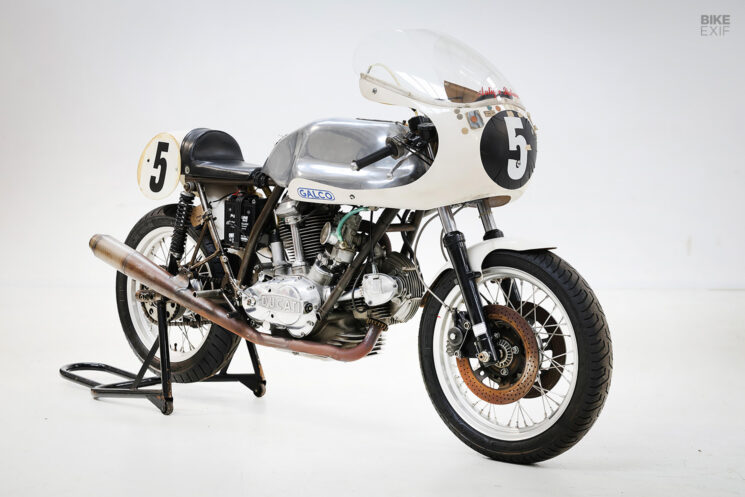
The leaves are falling (in my hemisphere anyway), and in addition to running up our odometers in the coming weeks, fall also means another one of Bonhams’ remarkable Autumn Stafford Sales. The current tally for the 2024 sale is up to 183 Lots, consisting of all types of vintage motorcycles and projects, and the live auction takes place at the Staffordshire County Showground on October 12 and 13.
As is customary, we perused the Lots and picked five of the most interesting motorcycles for a quick history lesson, as every leaky antique has a story to tell.
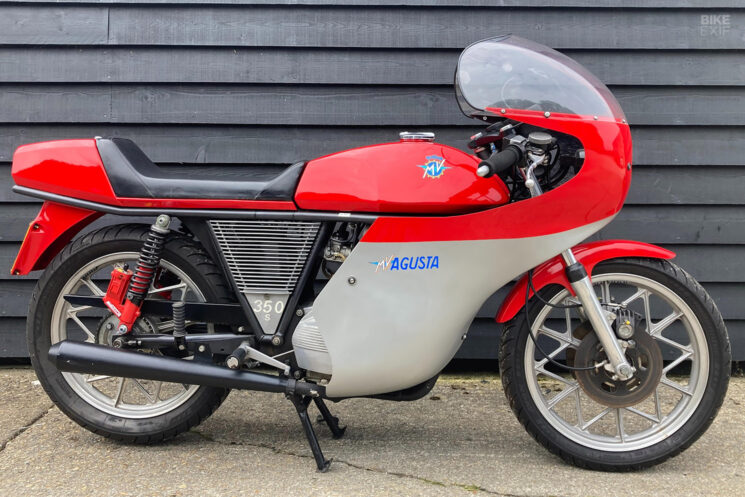
1976 MV Agusta 350 Sport Like many of its boutique European peers, MV Augusta found itself in hot water in the early 1970s, predominantly from the onslaught of affordable motorcycles pouring out of Japan’s ports. The situation at MV worsened with the passing of founder Count Domenico Agusta in 1971, and without a serious shift in the company’s direction, bankruptcy was inevitable. MV needed to shed its image of dated 1950s styling, and the 350 Sport model would be the cornerstone of this effort.
Working with what they had, MV Augusta breathed new life into the bones of the existing 350B model while famed Italian designer Giorgetto Giugiaro penned completely refreshed cosmetics. The result was a bike that embodied MV’s new direction, with a racy streamlined fuel tank, a full-length, cafe-inspired saddle with an integrated mudguard hanging off the back. 18-inch Snowflake cast alloys were also used, and a sporty full fairing was an eye-catching option. Rear-set pegs and clip-on bars hinted at its sporty intentions, even if they proved uncomfortable in practice.
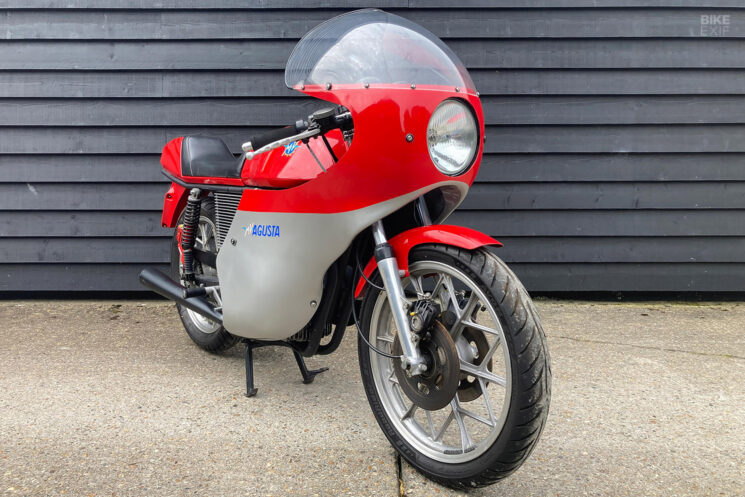
The 349 cc parallel twin from the 350B was no spring chicken, and its basic design was derived from an even older 250. MV updated the engine with a fresh cylinder head design and eeked output up to 34 hp at 8,500 rpm. Significant effort went into the design of a new chassis though, constructed entirely from steel tubing, whereas older designs employed some use of sheet metal sections. With this serious upgrade in rigidity, MV fit the 350 Sport with top-quality suspension from Ceriani and Scarab triple-disc braking.

The new ’75 350 Sport looked the business, even if its drivetrain was aged technology, and its top-spec running gear made for a thrilling and dependable machine in the hands of an experienced rider. Paving the way for the coming modern generation of MVs, just shy of 2,000 350s were built across two model variants.
In our opinion, this 1976 MV 350 selling at Bonhams is poised to be an excellent investment. It presents in excellent, albeit non-running, condition, and is estimated to bring just $3,900 to $5,200 [£3,000 to £4,000].
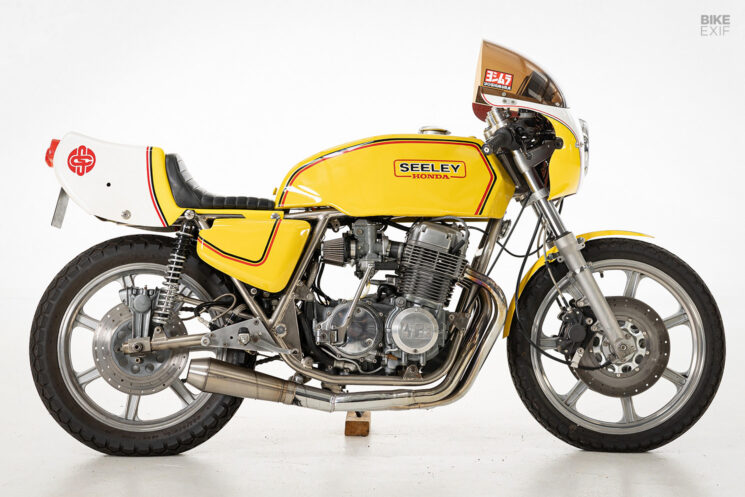
1976 Seeley-Honda CB750 Honda was tired of sitting on the sidelines by the late 1960s, but as long as the AMA limited the displacement of overhead-valve engines to 500 cc, side-valve engines like the HDs enjoyed a handsome advantage in displacement. Of course, all that would change with a new AMA ruling in 1970, and Honda responded with the ‘King of Motorcycles,’ a 736 cc SOHC four-cylinder that produced a reliable 68 hp in street trim. Sounds like a world-beater, and it might have been if Honda had given the chassis more than a passing thought.
The CB750 production bike was hailed for its performance and sophistication, but the frame was certainly its weak link for aggressive riding. Mass-produced with shoddy welds and cruising geometry, top racers all but disregarded the ill-handling production Honda frames, and manufacturers like Bimota, Egli and Rickman sold proprietary designs that righted Honda’s wrongs.

Ace British chassis builder Colin Seeley was also drawn to the marketing possibilities the CB750 offered. After retiring from a successful racing career, Seeley had forged a reputation for some of the best handling road racing bikes available—starting with Matchless engines in the early 1960s, and eventually Japanese powerplants from Yamaha and Suzuki.
Instead of an all-out racer, Seeley’s Honda CB was a single-seat sport bike of the highest order, employing a lightweight proprietary chassis made from his standard Reynolds 531 tubing with a shortened wheelbase. The fuel tank, exhausts and seat were of Seeley’s own design, and a fabricated swingarm was an available extra. Finished in high-luster nickel plating with white bodywork, the Seeley-Honda was a substantial upgrade in handling and performance, with the rock-solid reliability of Honda’s SOHC 750 mill.
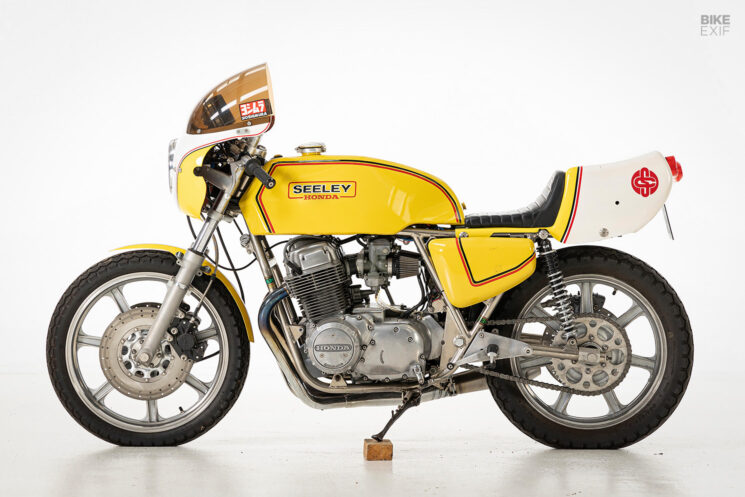
Built to the highest standard, Seeley would go on to build limited-edition motorcycles in partnership with Honda, including the Phil Read Replica TT Formula 1 roadsters and Seeley-Honda TL200 trials bike.
This 1976 Seeley-Honda offered by Bonhams is a final example of the marque, boasting fitting upgrades and custom graphics over Seeley’s white finish. In running condition with just over 35,000 miles on the clock, the Seeley-Honda is expected to bring $9,200 to $13,000 [£7,000 – £10,000].
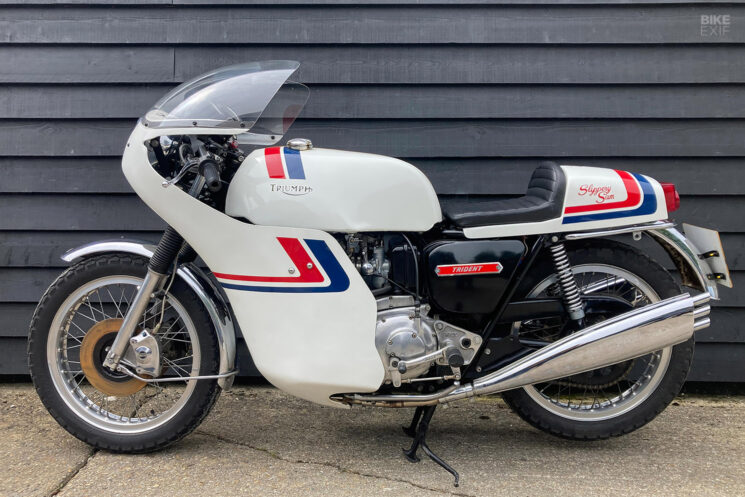
1976 Triumph T160 Trident ‘Slippery Sam’ Replica To the victor go the spoils, but sometimes a charismatic runner-up is engrained more in our collective memories. ‘Slippery Sam’ didn’t even make the podium, but against strong odds, the oil-soaked works Triumph Trident of Percy Tait and Steve Jolly rolled across the line in fifth, and in doing so became a permanent piece of Triumph lore.
The scene was the 1970 French Bol d’Or held at Linas-Montlhéry, and three specially prepped Triumph Tridents showed great promise to win the 24-hour endurance event. After 469 laps, 1,838 miles and four drive chains, the works Trident of Paul Smart and Tom Dickie cruised to a victory, besting the competition by nine laps. Further back, Tait and Jolly’s works Trident dealt with more extenuating circumstances.
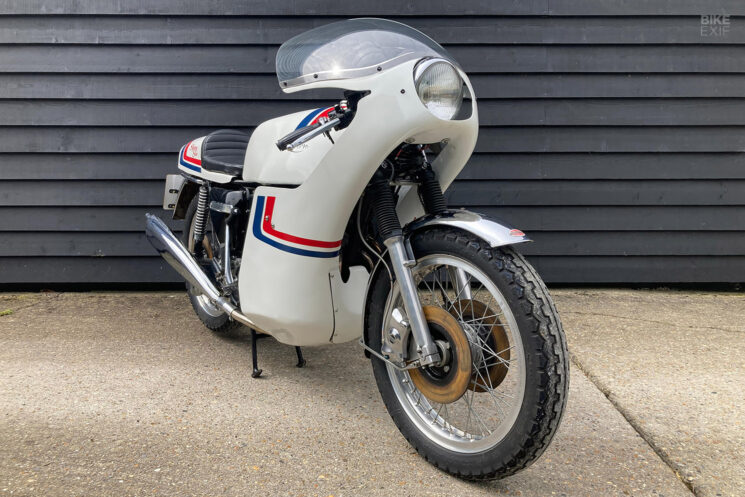
The exact details of the oily mess that prompted the moniker are up for debate, and the most interesting narrative states that a last-minute change in oil type caused sludge to develop in the sump, presumably causing oil to leak from all the vulnerable points. The ‘Sam’ in question is said to be everyone from a works Triumph transport man, to one of the mechanic’s girlfriends—draw your own conclusions—but the name Slippery Sam stuck better than any sludge could.
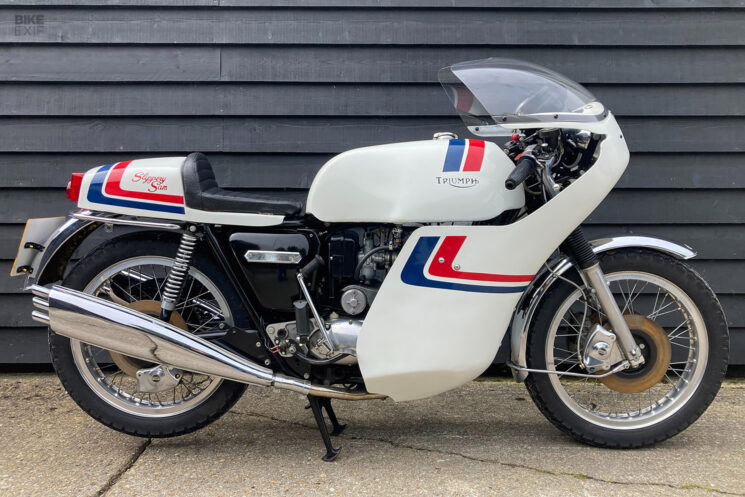
After this, it seems that the Tait/Jolly Triumph, and possibly its sister bikes as well, regularly flew the Slippery Sam banner, and Sam is credited with five consecutive Isle of Man TT wins in the early 1970s. Even as the doors were closing at Norton Villers Triumph, Sam trudged on, and the Trident we’re looking at today was built in 1976 by race shop foreman Les Williams.
Based on a new T160, this was the second Slippery Sam replica Williams built, and in addition to the full racer bodywork, the bike was fit with dual front discs, a works-style exhaust, rear-set pegs and clip-on bars. Covering 7,161 miles since new, Bonhams estimates the 1976 T160 Trident will bring $7,900 to $11,000 [£6,000 – £8,000].
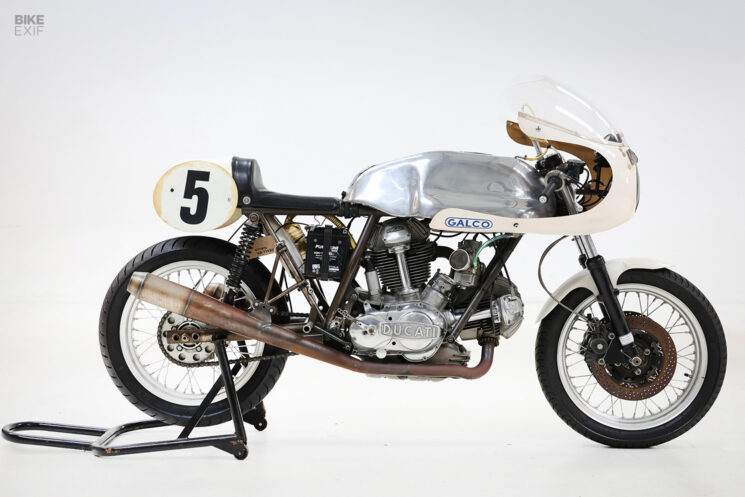
Galco Ducati 750 Paul Smart and Bruno Spaggiari’s 1-2 finish at the 1972 Imola 200 changed the trajectory of the Ducati brand overnight. A marque that few considered to be a real contender in the top echelon of road racing had toppled the favored MV Augusta of Giacomo Agostini, and they’d done so on a bike that was not far removed from the production model. With its stock soaring, the Ducati brass pledged to devote even more effort in 1973.
Over the winter of 1972, Ducati refined their works machines to an even higher state of tune, starting with Fabio Taglioni reworking the 90-degree with a shorter 64.5 mm stroke, larger 86 mm bore and a tighter valve angle. After revising the frame slightly, a new swingarm was developed that allowed the wheelbase to be changed for different circuits. The resulting machine was significantly lighter at 326 pounds, and the reworked engine produced 100 bhp.

Three works machines were prepped for the 1973 Imola 200, but faced stiff competition from Yamaha’s new TZ350. Spaggiari still managed a strong second-place finish, but the writing was on the wall—the era of two-stroke domination had arrived—and Ducati pivoted to endurance racing in the following years.
Despite the changing times, there’s little doubt that the 1973 Desmo 750s represent the pinnacle of Ducati L-twin evolution, prompting this ’73 Imola 750 recreation crossing the block at Bonhams’ Autumn Stafford Sale. The bones of the Ducati were fabricated by known Ravensdale, Washington, chassis expert Reed Galbraith of Galco, with the chassis constructed of TIG-welded aircraft chrome-moly thin wall tubing.
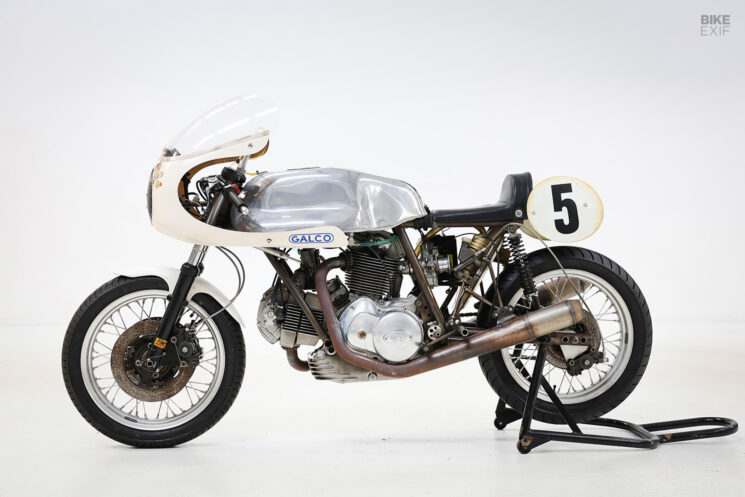
Since an exact replica of the short-stroke ’73 L-twin was unobtainable, a round-case 750GT engine was extensively modified with Desmo valve gear, Imola cams, Dell’Orto 41 mm carburetors, twin-plug ignition and an ‘Imola’ exhaust by Sid Tunstall. Campaigned in numerous events by its commissioner, the bike was a regular top finisher in 750 cc events from 1989 to 1993.
Offered in running condition, Bonhams states that the bike has never been dropped, and has had just one owner since new. The $13,000 to $18,000 [£10,000 – £14,000] estimate makes for an interesting proposition, considering the original 1973 Spaggiari Imola bike was valued at around $400,000 in the early 2000s.

1912 Indian Model D Just over 10 years in the business and the outlook at the Hendee Manufacturing Company couldn’t have been better. Spurred on by the scores of race victories and long-distance records set by Indian motorcycles, Hendee had become the largest motorcycle manufacturer in the world, and 1913 would prove to be the height of Indian’s production.
In addition to the bicycle racing experience founders Oscar Hedstrom and Oliver Hendee brought to Indian, there was also a constant dedication to mechanical excellence that kept Indian on top in these years. Where competitors used drive belts, Indians used a chain drive from the start, and the company debuted a leaf-sprung fork by 1910. That same year, a clutch and two-speed transmission was optional on select models, and Indian would unveil a leaf-sprung rear suspension by late 1912. Indian’s first big twin was also fresh on the market, displacing 988 cc, and offering—wait for it—7 hp.
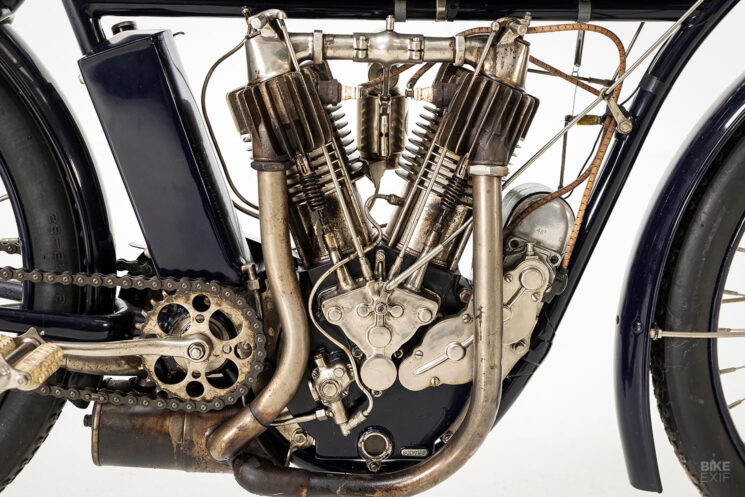
The Indian was the motorcycle to beat in those days, proving dominant on dirt circuits and board tracks, but their largest triumph was surely an underdog 1-2-3 finish at the Isle of Man TT in 1911. A massive achievement for an American firm still in its infancy, Indian had become a global player, and the period leading up to World War I would prove to be Indian’s golden years.
Indian’s early production excellence is displayed in this stunning 1912 Model D twin selling at Bonham’s Autumn Stafford Sale. The bike was allegedly stored inside a house from 1955 until 1988 when it was acquired by the seller, and a nut-and-bolt restoration was performed between 2000 and 2007. The Indian is powered by the 988 cc V-twin and uses the rigid frame of the early 1912 production bikes. Bonhams cautions that the bike will need some recommissioning before use, and estimates it will bring between $37,000 and $50,000 [£28,000 – £38,000].
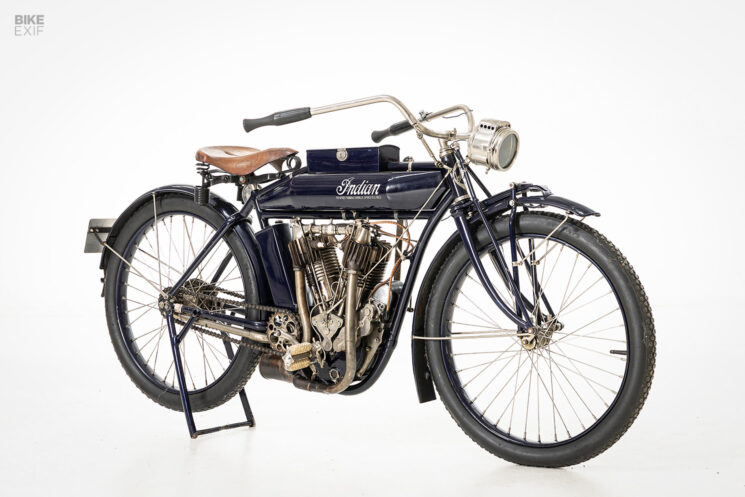
from Bike EXIF https://ift.tt/y5c3wQl
No comments:
Post a Comment